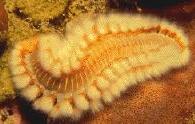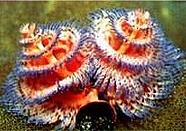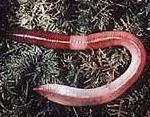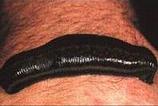
(errant polychaete) |

(sedentary polychaete) |
PHYLUM ANNELIDA
(Tree and traits from
|

(oligochaete) |

(leech) |

(errant polychaete) |

(sedentary polychaete) |
PHYLUM ANNELIDA
(Tree and traits from
|

(oligochaete) |

(leech) |
===3=== "SubCl." Errantia (errant marine segmented worms)
==2==Polychaeta===|
| ===4=== "SubCl." Sedentaria (sedentary marine segmented worms)
<<=1===|
| =====6=============== Oligochaeta (earthworms & relatives)
| |
=5==| ==8======== Acanthobdellida (primitive leech-like annelids)
=====7====|
==9======== Hirudinea (true leeches)
Back to Zool 250 tree for animal phyla or Protostomia
TRAITS SUPPORTING EACH CLADE (** plesiomorphic- a primitive state, not unique to clade):
|
b) simple prostomium** c) peristomium: a unique pre-segment surrounding the mouth d) no parapodia** e) multiciliated cells** f) chitinous setae in setal sacs** g) separate sexes, gametes from body wall (no permanent gonads)** h) segmented ventral nerve cord** i) closed circulatory system with capillaries and contractile vessels or hearts j) nephridia with nephrostome opening in segment anterior to nephridiopore b) parapodia c) gametes from body wall (no permanent gonads)** d) complex prostomium b) pharynx with jaws (most) b) segments usually differ in form c) jaws usually absent |
b) simple prostomium** c) no parapodia** d) hermaphroditic e) clitellum (produces the cocoon in which eggs are laid) f) permanent gonads b) typhlosole (earthworms) b) fixed number of body segments c) setae restricted to a few anterior segments d) posterior (and often anterior) sucker e) superficial annuli in body wall b) setae restricted to a few anterior segments** c) body of 30 segments b) body of 33 or 34 segments c) coelom unsegmented d) no setae |